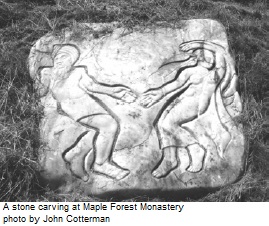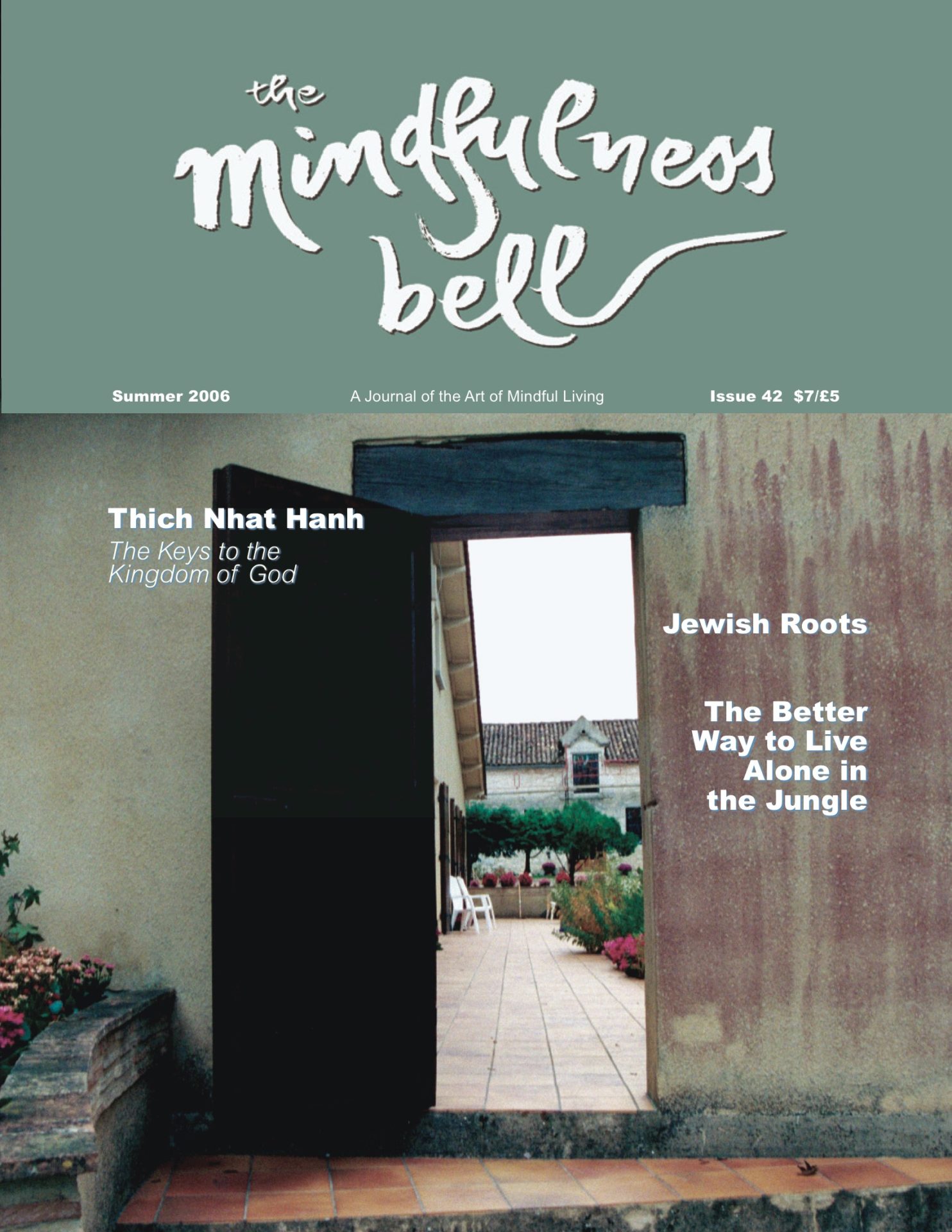By Bruce L. Hilsberg
Bruce Hilsberg passed away on March 29, 2005; you may read an essay by his wife Karen in issue 39 of the Mindfulness Bell.
When I first became a student of Thich Nhat Hanh over ten years ago, I never thought that my personal interest in meditation, mindfulness practice, and the dharma would become an essential part of my work as a psychologist at a state psychiatric hospital.
By Bruce L. Hilsberg
Bruce Hilsberg passed away on March 29, 2005; you may read an essay by his wife Karen in issue 39 of the Mindfulness Bell.
When I first became a student of Thich Nhat Hanh over ten years ago, I never thought that my personal interest in meditation, mindfulness practice, and the dharma would become an essential part of my work as a psychologist at a state psychiatric hospital.
I had practiced mindfulness with my wife in the tradition of Thich Nhat Hanh, attended days of mindfulness with Thay when he visited California, and participated in meditation classes and dharma discussions with a local Order of Interbeing teacher. Over time, I have taught mindfulness techniques to some of the patients in my private practice to help them find relief from symptoms including insomnia, depression, substance abuse, eating disorders, relationship difficulties, manic depression, and anxiety. Still, my mindfulness practice felt compartmentalized. In the context of working at the state hospital, I still subscribed to the medical model of illness and disease in which I had been trained. During work, I contemplated curing mental illnesses and reducing symptoms rather than seeing individuals as people with strengths and a desire to build on these.

But all that changed last year, when an outside consultant was brought in to help improve the state hospital where I had worked for over eleven years. It just so happened that this consultant, who served many state psychiatric hospitals in the United States, had cultivated a Soto Zen Buddhist practice and had integrated mindfulness training into his work. When the consultations with our hospital began, I found a door through which I could enter to begin integrating my personal and professional beliefs and practices. This is the story of my journey this past year and a half.
Our system at the state hospital has watered many seeds of negative habit energy over the past decades, resulting in problems that need new solutions. For example, the system encountered difficulties in accurately diagnosing and properly treating individuals with serious and persistent mental illnesses. With the help of our consultant we are moving in the direction of systemic change for the betterment of the people connected to the hospital: administrators, staff, individuals with psychiatric disabilities, family members and the community.
From the Medical Model to the Recovery Model
One of the first methods we are using is stopping and looking deeply at ourselves and each other. While we are well aware of changes that we would like to see, part of my practice has become to accept that I am where I need to be in this moment and the hospital too is where it needs to be. Sangha building has also been a very important part of the process. We are forming connections with each other to support mindfulness in our work environment so that we can embody the practice and then bring the fruits of our practice to the hospital and the people with whom we work. In this regard, we have struggled to get out of “automatic pilot” and instead to recognize our habits, realize what we are thinking and doing, and look deeply so that we can make better choices for ourselves. In turn, we can help others to make better choices for themselves. This forms the basis of a new model of treatment for mental disorders called the recovery model.
In the recovery model, we think about individuals—what helps them and what hinders them in their lives. We talk about choices and empowerment. In the same way that Thay talks about our store consciousness with our positive and healthy seeds as well as our negative and unhealthy seeds, the recovery model sees individuals as having seeds of strength and seeds of weakness. In the old medical model, we might have asked, “Why was the individual so ill? How can we treat and cure his illness?” Now with the recovery model, we ask, “How did the individual sustain herself in the face of her illness? How can I help support her strengths and help her to recognize and water her own seeds of health, growth and well-being?” We now focus on conducting strengths-based conversations with them instead of routine diagnostic work-ups (though accurate diagnoses are still considered very important).
The research that is now emerging in the field of psychology indicates that mindfulness training is an incredibly effective treatment for many people suffering from psychiatric disorders such as chronic depression and obsessive compulsive disorder. The treatment does not necessarily make the disorder completely vanish, but it can empower individuals to manage their symptoms effectively, to discontinue negative cycles of thought and behavior, and to lead more adaptive and contented lives outside of hospitals and in the community. Furthermore, many individuals with psychiatric disabilities have benefited from mindfulness training as they learn to change the relationship they have with the symptoms of their illness and to feel a sense of control in their lives.
What Mindfulness Looks Like
Over the past year and a half, as I have been mentored by our consultant, my own mindfulness practice has deepened immensely. At work, I try not to operate on automatic pilot anymore. I don’t see events as meaningless. I see the importance of my speech and my actions, and I appreciate that all I have right now is the present moment and my own presence in the moment. I spend a great deal of time in meetings, and my behavior at meetings has changed. I’ve become more present in the meetings. I recognize that while there is a lot to do, what I am doing in the moment is what I need to be doing right now. I listen deeply to others’ speech, I don’t interrupt others, and I breathe mindfully. I realize that my list of things to do does not control me. I practice non-attachment to outcomes happening within a certain arbitrary period of time. I understand that I do not need to balance my time, but to find balance in my life. I realize that my list of things to do is there to assist me in seeing what needs to be done and what my priorities are, but that is all. I feel a sense of acceptance in my work of what is. Just as in my life, rather than feeling that I need to chase after a goal, buy something, or accomplish something to feel better, I am just being in acceptance of what is.
At work, I have begun to offer a weekly meditation group for members of the hospital staff. For the last couple of months, every Thursday at lunchtime we sit on chairs or on the floor in the administration building and meditate together for half an hour.
Though I have attended meetings in this room for many years, now that I meditate there, I am aware of new sounds that I never heard before. For example, I am aware of the sound the clock makes as it ticks. We have core members who are present almost every week, and we also have people who come and go. The energy of the group practice is becoming strong, and after the practice we discuss our experiences together in a spirit of acceptance, understanding, and lack of judgment.
One thing I dream of is a time when these practices will be so much a part of the institution that before a treatment planning meeting, the treatment team will take some mindful breaths together and set an intention for the meeting. This would help each person at the meeting to move beyond their own tendency to be on automatic pilot and to truly experience the individual as an individual, rather than seeing the purpose of the meeting as a task that must be accomplished.
In my private life, my wife and I have made a new commitment to meditate together every morning before our young children wake up as a way to support each other in the practice. We also have had wonderful opportunities to spend time at Deer Park Monastery in Escondido and to practice breathing, sitting, walking, eating and working meditation as a family with the support of the monastic Sangha. We have come to see the truth for us in the Dharma Seal, “You have arrived, you are home.” We have also recently formed a Sangha in our area to offer the practice to our family, co-workers, neighbors, and friends on a weekly basis and to seek support for our Order of Interbeing aspirant training.
To some, the changes that have happened at our hospital are remarkable and inspiring. To others, it seems that change is moving at a snail’s pace. Many people within the hospital are struggling with the changes and feel angry, resentful, or helpless. Others are embracing the changes and feel the freshness of the new approaches as they are introduced. For me, some days are full of frustrations as more entrenched problems in the system emerge into the light of day. “Breathing in, I know I feel frustration. Breathing out, I smile to my frustration and am grateful that I am alive.” Other days are exciting as new standards of care for the individuals we serve are implemented. Overall, I can say that mindfulness is now a part of my daily work life as well as my personal life. Through mindfulness training we are working to improve our hospital, the treatment practices, and the quality of life of the individuals we serve, as well as staff, administrators and family members. It has not been easy to introduce these ideas into a bureaucratic system, but my work is enormously meaningful to me now in ways that it has never been before.
Bruce L. Hilsberg, True Commitment of the Heart, was Chief of Psychology at Metropolitan State Hospital in Norwalk, California. He and his wife practiced with the Organic Garden Sangha in Culver City, California and at Deer Park Monastery in Escondido, California.
From: Spoken Like a True Buddha, an unpublished compilation of stories about mindfulness practice in everyday life, edited by Carolyn Cleveland Schena and Sharron Mendel.

